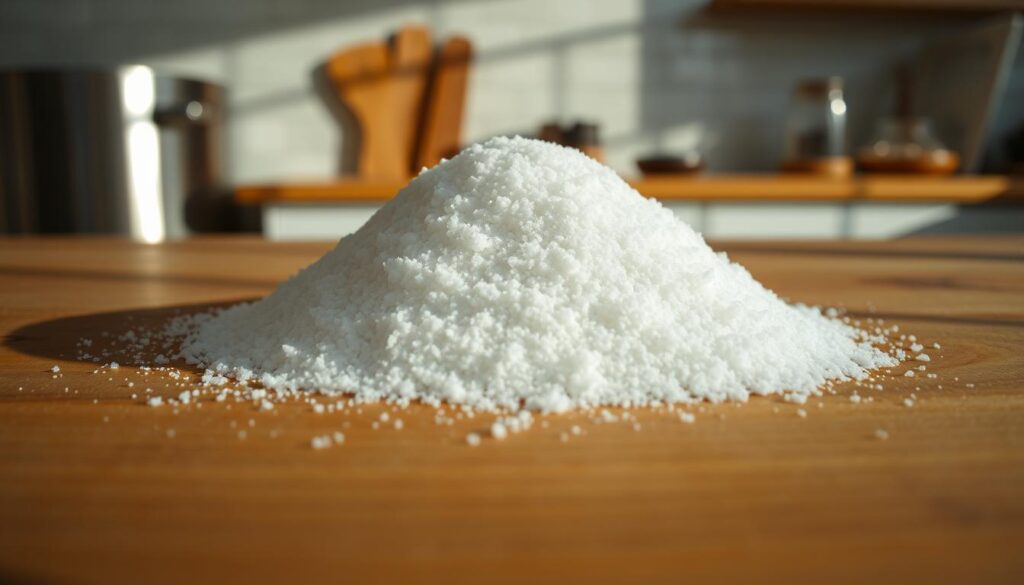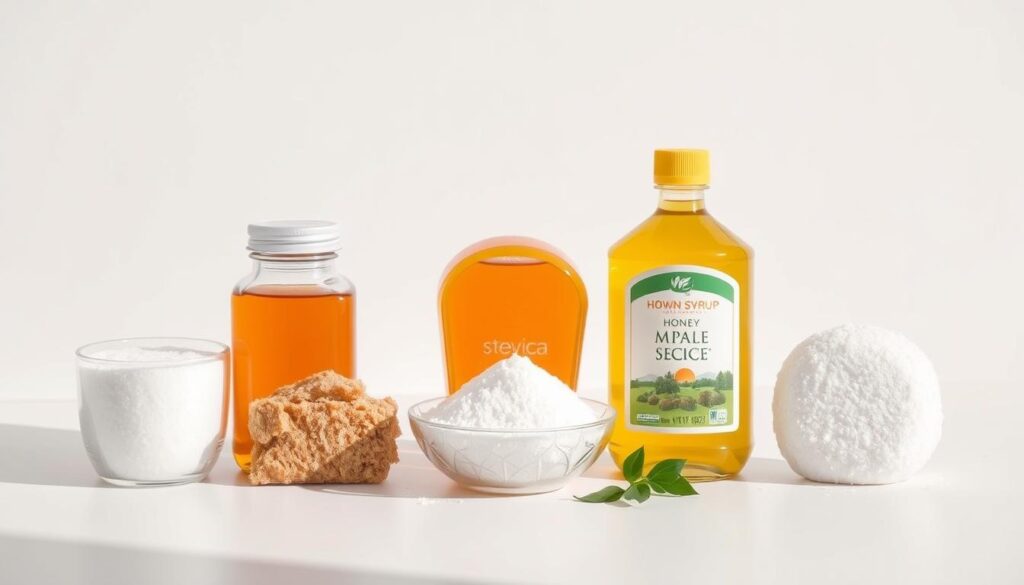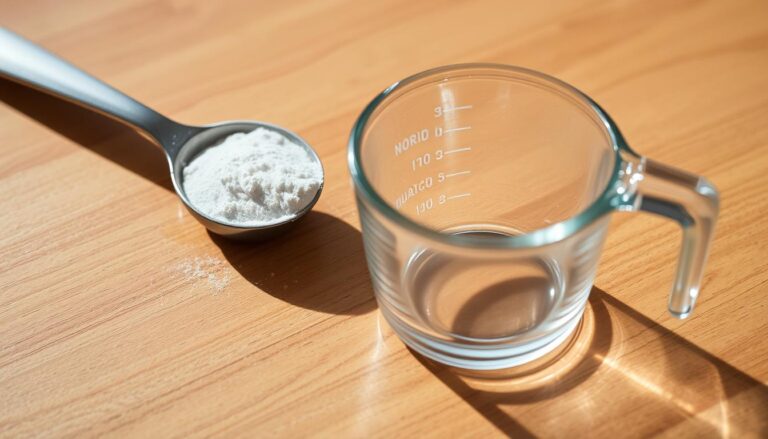What Is Caster Sugar and What’s a Good Substitute?
Baking is an art that requires precision, and the type of sugar used can significantly impact the final product. Caster sugar, also known as superfine sugar, is a popular choice among bakers due to its ease of dissolution and smooth texture.

However, there are instances when Caster Sugar is not readily available, and a substitute is needed. Whether you’re in the middle of a recipe or looking for alternatives due to dietary restrictions, understanding the substitutes is crucial.
Key Takeaways
- Understanding Caster Sugar and its role in baking
- Identifying the need for substitutes in recipes
- Exploring alternatives to Caster Sugar
- Learning how to choose the right substitute
- Discovering tips for using substitutes effectively
The Science Behind Caster Sugar
Understanding the science behind caster sugar is crucial for appreciating its role in various culinary applications. Caster sugar, also known as superfine sugar, has distinct properties that make it a preferred choice in many recipes.
Chemical Composition and Crystal Structure
Caster sugar has the same chemical composition as granulated sugar, being sucrose. However, its crystal structure is finer, which affects its performance in cooking and baking. The smaller crystal size allows for quicker dissolution and provides a smoother texture in desserts.
How Grain Size Affects Culinary Applications
The grain size of caster sugar significantly influences its use in culinary applications. Its fine texture makes it ideal for recipes where quick dissolution is necessary.
Dissolution Rate Comparison
Caster sugar dissolves faster than granulated sugar due to its smaller crystal size. This property is particularly beneficial in meringues and soufflés, where a smooth texture is crucial. In contrast, granulated sugar may not dissolve as quickly, potentially affecting the final texture of the dessert.
Heat Response Properties
When exposed to heat, caster sugar caramelizes more evenly than granulated sugar. This characteristic is essential in sugar work and caramel recipes, where a smooth, consistent texture is desired.
In conclusion, the science behind caster sugar reveals its unique advantages in culinary applications. Its fine texture, quick dissolution rate, and even heat response properties make it a valuable ingredient in many sweet dishes.
Caster Sugar: The Baker’s Secret Weapon
In the world of professional baking, caster sugar is revered for its fine texture and quick dissolving properties. This characteristic makes it an essential ingredient in many recipes, particularly those requiring a smooth texture.
Historical Development in Professional Baking
Caster sugar has a rich history in professional baking, dating back to the 18th century when bakers began seeking finer sugar products to improve their craft. The development of caster sugar was a significant milestone, as it provided bakers with a product that dissolved quickly and evenly, enhancing the texture of baked goods.
According to
“The Oxford Companion to American Food and Drink,”
the evolution of sugar refining techniques played a crucial role in the production of caster sugar. This advancement allowed for mass production, making caster sugar a staple in professional bakeries.
Regional Naming Conventions
Caster sugar is known by different names in various regions, reflecting local terminology and preferences.
Superfine Sugar in America
In the United States, caster sugar is commonly referred to as superfine sugar. This naming convention highlights the sugar’s fine grain size, which is a key characteristic distinguishing it from granulated sugar.
Berry Sugar in Canada
In Canada, particularly in some Quebecois recipes, caster sugar is sometimes called “berry sugar.” This term is less common globally but is significant in Canadian culinary traditions.
| Region | Common Name for Caster Sugar |
|---|---|
| United States | Superfine Sugar |
| Canada (Quebec) | Berry Sugar |
| UK and Australia | Caster Sugar |
Caster sugar’s versatility and the various names it goes by underscore its importance in global baking traditions. Whether called superfine sugar or berry sugar, its unique properties make it a valuable ingredient in many recipes.
Common Uses of Caster Sugar in Modern Cuisine
In modern cuisine, caster sugar plays a crucial role in achieving the perfect texture and flavor in numerous dishes. Its superfine crystals make it an ideal ingredient for a variety of culinary applications.
Classic Meringues and Soufflés Case Study
Caster sugar is particularly important in the preparation of classic meringues and soufflés. Its fine texture allows it to dissolve quickly and evenly, providing stability and structure to these delicate desserts. The use of caster sugar ensures that meringues are crispy on the outside and chewy on the inside, while soufflés rise perfectly due to the even distribution of sugar.
“The key to a successful meringue is the incorporation of caster sugar, which provides the necessary sweetness and texture.” –
Renowned Pastry Chef
Cocktail Applications and Mixology
Caster sugar is also a valuable ingredient in mixology, particularly in the preparation of cocktails that require a touch of sweetness without the coarseness of granulated sugar. Its quick-dissolving properties make it ideal for syrups and simple syrups used in various cocktails.
| Cocktail | Use of Caster Sugar |
|---|---|
| Mojito | Dissolves quickly with mint leaves |
| Daiquiri | Used in simple syrup for sweetness |
Delicate Pastries and Sponge Cakes
In baking, caster sugar is essential for creating delicate pastries and sponge cakes. Its fine crystals ensure that the sugar is evenly distributed throughout the batter, resulting in a tender crumb and a delicate texture.
Victoria Sponge Test Kitchen Results
In a test kitchen experiment, using caster sugar in a Victoria sponge cake recipe resulted in a cake that was notably lighter and more tender than one made with granulated sugar.
The results were impressive, with tasters praising the cake’s texture and flavor. This demonstrates the significant impact that caster sugar can have on the quality of baked goods.
Caster Sugar vs. Other Sugar Types: Practical Differences
Understanding the differences between caster sugar and other sugar types is crucial for achieving the perfect texture and flavor in baking and cooking. Caster sugar is often compared to granulated sugar, powdered sugar, and brown sugar, each with its unique characteristics and uses.
Granulated Sugar Comparison
Granulated sugar is the most commonly used sugar in households. The primary difference between caster sugar and granulated sugar lies in their grain size. Caster sugar has a finer texture, making it easier to dissolve and incorporate into recipes.
Texture and Mouthfeel Analysis
The finer grain of caster sugar provides a smoother mouthfeel and quicker dissolution, which is particularly important in delicate desserts like meringues and soufflés.
Powdered Sugar Differences
Powdered sugar, also known as confectioner’s sugar, is even finer than caster sugar and often contains anti-caking agents to prevent clumping.
Anti-Caking Agents and Their Effects
Anti-caking agents in powdered sugar can affect the texture and flavor of baked goods. It’s essential to consider these additives when substituting caster sugar with powdered sugar.
Brown Sugar Substitution Challenges
Brown sugar contains molasses, giving it a distinct flavor and moisture content compared to caster sugar. Substituting brown sugar for caster sugar can alter the flavor profile and texture of a dish significantly.
| Sugar Type | Grain Size | Common Uses |
|---|---|---|
| Caster Sugar | Fine | Meringues, soufflés, delicate pastries |
| Granulated Sugar | Medium | General baking, cooking |
| Powdered Sugar | Very Fine | Dustings, frostings, icings |
| Brown Sugar | Medium | Baked goods, sauces, marinades |
Market Availability and Price Point Analysis of Caster Sugar
Caster sugar, a staple in many professional kitchens, has varying levels of availability across different regions in the United States. This variability can affect both professional bakers and home cooks who rely on this ingredient for specific recipes. The market availability of caster sugar is influenced by several factors, including distribution channels, consumer demand, and competition from other sweetener options.
Regional Availability in American Stores
Caster sugar is more commonly found in specialty baking stores and larger supermarkets that cater to a diverse customer base. In major cities like New York and Los Angeles, it’s relatively easy to find caster sugar in most baking supply stores. However, in smaller towns or regions with less emphasis on specialty baking, it might be more challenging to locate.
Cost Comparison with Other Sweeteners
When comparing the price of caster sugar to other sweeteners, it’s generally more expensive than granulated sugar but less expensive than superfine sugar. The price difference is due to the processing and grinding required to achieve its fine texture. For instance, a pound of caster sugar can cost between $1.50 to $3, depending on the brand and quality.
Case Study: Consumer Purchasing Patterns
A recent study on consumer purchasing patterns revealed that bakers who frequently use caster sugar tend to buy it in larger quantities and are more likely to shop at specialty stores. The study also found that consumers are willing to pay a premium for high-quality caster sugar that is certified organic or fair-trade.
As consumer demand continues to evolve, manufacturers and retailers are adapting by offering a wider range of sweetener options, including caster sugar, in various packaging sizes to meet different consumer needs.
Creating Your Own Caster Sugar: DIY Methods
For those who can’t find caster sugar in stores, creating it DIY-style is a viable and easy solution. Caster sugar, with its fine texture, is a crucial ingredient in many recipes, from meringues to soufflés. Fortunately, you can make it at home using common kitchen appliances.
Food Processor Technique Case Study
One of the most effective ways to make caster sugar is by using a food processor. Simply add granulated sugar to the processor and blend until it reaches the desired consistency. It’s essential to be cautious and check the sugar frequently to avoid over-processing into powdered sugar.
Equipment Comparison Results
When using a food processor, the results can vary depending on the model and blade type. Generally, a sharp blade and short processing times yield the best results. Here’s a comparison of different processing times and the resulting sugar texture:
| Processing Time | Sugar Texture |
|---|---|
| 10 seconds | Coarse, some granules remain large |
| 20 seconds | Fine, most sugar is caster sugar consistency |
| 30 seconds | Very fine, approaching powdered sugar |
Coffee Grinder Method
A coffee grinder is another appliance that can be used to make caster sugar. It’s particularly effective for small quantities. Simply grind the granulated sugar in short pulses until you achieve the desired texture. Be aware that coffee grinders can generate heat, which might affect the sugar’s texture.

Blender Options and Limitations
Blenders can also be used to make caster sugar, although they might not be as effective as food processors for large quantities. The key is to blend in short intervals and check the consistency frequently. Some blenders may produce uneven textures, so it’s crucial to sift the sugar after blending.
Preventing Powdered Sugar Formation
One of the challenges when making caster sugar at home is avoiding the production of powdered sugar. To prevent this, it’s essential to monitor the processing time closely and stop as soon as the sugar reaches the caster sugar consistency. Sifting the sugar after processing can also help achieve a uniform texture.
Natural and Alternative Sweetener Substitutes
The quest for healthier alternatives to caster sugar has led to the exploration of various natural sweeteners. These alternatives not only offer different flavor profiles but also cater to various dietary needs and preferences.
Honey and Liquid Sweetener Adjustments
When substituting caster sugar with liquid sweeteners like honey, it’s crucial to adjust the recipe accordingly. Honey, for instance, adds moisture and a distinct flavor that can enhance baked goods and desserts.
Moisture Content Compensation
To compensate for the added moisture, bakers often need to reduce the amount of liquid in the recipe or add extra flour to achieve the right consistency. This adjustment is vital to prevent overly moist or soggy textures.
Coconut Sugar Case Study
Coconut sugar is another popular alternative to caster sugar, offering a lower glycemic index and a rich, caramel-like flavor. It can be used 1:1 in many recipes, although its flavor profile may alter the final product’s taste.
Stevia and Monk Fruit for Low-Carb Baking
For those engaged in low-carb baking, sweeteners like stevia and monk fruit are attractive options. These sweeteners are significantly sweeter than caster sugar, so only a small amount is needed.
Bulking Agent Requirements
One challenge with using stevia and monk fruit is that they lack bulk, which is often provided by sugar in recipes. To address this, bakers may need to incorporate bulking agents like almond flour or coconut flour to achieve the desired texture.
In conclusion, natural and alternative sweeteners offer versatile options for those looking to substitute caster sugar in their recipes. By understanding the unique properties of these sweeteners, bakers and cooks can make informed choices to meet their dietary needs and preferences.
Recipe-Specific Substitution Guide
The need to substitute caster sugar arises frequently, and understanding how to do so without compromising the final product is crucial. Caster sugar’s unique properties make it ideal for certain recipes, but alternatives can be used effectively with the right guidance.
Meringue and Delicate Foam Case Studies
When making meringues or delicate foams, the substitution of caster sugar requires careful consideration. Sugar substitutes like granulated sugar or superfine sugar can work, but the texture may vary slightly. It’s essential to monitor the whipping process closely to achieve the desired consistency.
Caramel and Sugar Work Alternatives
For caramel and sugar work, substituting caster sugar with other sugars can affect the crystallization process. Using a sugar substitute with a similar grain size can help maintain the desired texture. However, it’s crucial to be aware of the potential for variation in flavor and texture.
Creamed Butter Applications
In recipes that involve creaming butter and sugar together, such as cakes and cookies, the type of sugar used can impact the final product’s texture and consistency. Creamed butter applications benefit from sugars that dissolve easily, making some substitutes more suitable than others.
Texture Analysis Results
- Caster sugar provides a smooth texture.
- Granulated sugar can be used but may result in a slightly grainier texture.
- Powdered sugar dissolves quickly but can make mixtures too sweet.

Understanding these differences is key to successfully substituting caster sugar in various recipes. By choosing the right substitute and adjusting the preparation method accordingly, you can achieve the desired outcome.
Professional Pastry Chef Insights on Caster Sugar Substitution
The art of sugar substitution is a nuanced one, with pastry chefs employing various strategies to achieve the desired results. In our exploration of caster sugar substitutes, we gained valuable insights from professional pastry chefs who shared their experiences and techniques.
Interview Findings from Test Kitchens
Our interviews with pastry chefs revealed that test kitchens play a crucial role in developing and refining sugar substitution techniques. Test kitchens allow chefs to experiment with different sweeteners and ratios, ensuring that the final product meets their high standards. For instance, one chef noted that using a combination of granulated sugar and corn syrup can help achieve the desired texture in meringues.
Restaurant Adaptation Strategies
Restaurant pastry chefs often face the challenge of adapting recipes to available ingredients. Flexibility is key when it comes to sugar substitution, as chefs must balance flavor, texture, and appearance. Some chefs opt for making their own caster sugar using a food processor or coffee grinder, while others prefer to use alternative sweeteners like honey or coconut sugar.
Troubleshooting Common Substitution Failures
Even experienced pastry chefs encounter issues when substituting caster sugar. Common problems include inconsistent texture, flavor imbalance, and appearance issues. To overcome these challenges, chefs recommend carefully adjusting the ratio of sweeteners and monitoring the final product’s texture and flavor. By understanding these potential pitfalls, bakers can better navigate the complexities of sugar substitution.
Conclusion: Selecting the Right Substitute for Your Needs
Choosing the right Sugar Substitutes can be daunting, but understanding the role of Caster Sugar in various recipes can simplify the process. Throughout this article, we’ve explored the characteristics of Caster Sugar and its applications in baking and cooking.
By considering the specific needs of your recipe, you can select a suitable substitute that maintains the desired texture and flavor. Whether you’re making meringues, soufflés, or delicate pastries, the right sugar substitute is crucial for achieving professional results.
With the knowledge of different sugar types and their uses, you can confidently experiment with various Baking Tips and techniques. Remember, the key to successful substitution lies in understanding the properties of Caster Sugar and its alternatives, allowing you to make informed decisions in your culinary endeavors.
By applying these insights, you’ll be well-equipped to tackle a wide range of recipes and create delicious treats that showcase your baking skills, all while utilizing the most suitable Sugar Substitutes for your needs.
FAQ
What is caster sugar, and how is it different from granulated sugar?
Caster sugar, also known as superfine sugar, is a type of sugar that has a finer texture than granulated sugar. Its smaller crystal size allows it to dissolve more easily, making it ideal for baking and cooking applications where a smooth texture is crucial.
Can I substitute caster sugar with granulated sugar in recipes?
While granulated sugar can be used as a substitute in some recipes, it may not provide the same texture and dissolution properties as caster sugar. However, you can make your own caster sugar by processing granulated sugar in a food processor or blender.
What are some common uses of caster sugar in baking and cooking?
Caster sugar is commonly used in making meringues, soufflés, delicate pastries, and sponge cakes. Its fine texture and easy dissolution make it an essential ingredient in many dessert recipes.
How do I store caster sugar to maintain its quality?
To maintain the quality of caster sugar, store it in an airtight container in a cool, dry place. This will help prevent moisture absorption and keep the sugar fresh.
Can I use caster sugar as a substitute for powdered sugar?
No, caster sugar and powdered sugar are not interchangeable. Powdered sugar contains anti-caking agents and has a much finer texture than caster sugar. Using caster sugar in place of powdered sugar may affect the texture and consistency of your final product.
Are there any natural alternatives to caster sugar that I can use in baking?
Yes, there are several natural alternatives to caster sugar, including coconut sugar, honey, and stevia. However, keep in mind that these alternatives may have different flavor profiles and textures, so you may need to adjust your recipe accordingly.
How do I make my own caster sugar at home?
You can make your own caster sugar by processing granulated sugar in a food processor, coffee grinder, or blender. Simply pulse the sugar until it reaches the desired consistency, being careful not to over-process it into powdered sugar.
What are some common challenges when substituting caster sugar with other types of sugar?
When substituting caster sugar, you may encounter challenges such as texture and flavor changes, as well as differences in dissolution rates. Be prepared to adjust your recipe and technique accordingly to achieve the best results.





